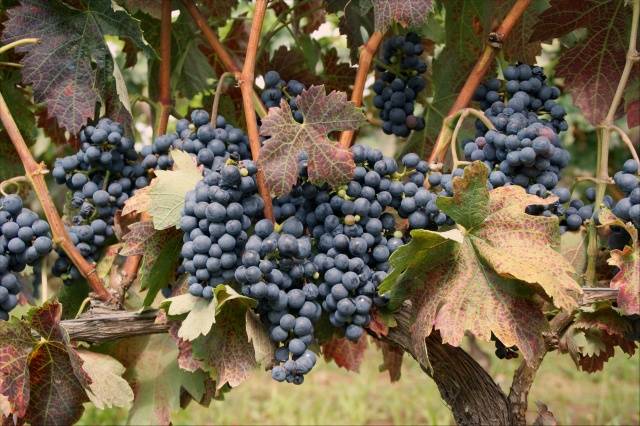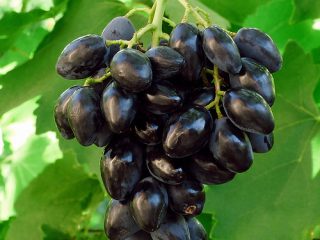Content
The basis of the vineyards of northern Spain is the Tempranillo variety, which is part of the raw material for famous vintage wines. The unique properties of the variety expanded the territory of its cultivation to the vineyards of Portugal, California, Argentina, and Australia. Grapes are also grown in the southern regions of Russia, albeit in limited quantities.
Description
The buds on the vine bloom late, the shoots ripen quickly. A young shoot of the Tempranillo grape, according to the description of the variety, with an open crown, crimson along the edges. The first five-lobed leaves are the same, yellowish-green, edged, densely pubescent below. The vine has long internodes, the leaves are large, wrinkled, deeply dissected, with large teeth and a lyre-shaped petiole. The bisexual, medium-density flower of the Tempranillo grape is well pollinated.
Long, narrow clusters are compact, cylindrical-conical in shape, medium in size. Round, slightly flattened, dark berries with a rich violet-blue hue, clustered close to each other. Tempranillo grapes, as emphasized in the description, contain a lot of anthocyanins. These coloring pigments affect the richness of the wine with visual velvety nuances. The thin skin has a matte coating.The pulp is dense, juicy, colorless, with a neutral odor. The berries are medium in size, 16 x 18 mm, weighing 6-9 g.
Tempranillo grape cuttings can be sold under local synonyms: Tinto, Ul de Liebre, Ojo de Liebre, Aragones.
White variety
At the end of the 20th century, in the Rioja region, the original traditional region for growing the variety, a variety of Tempranillo grapes with green-yellow fruits was discovered. It began to be used for winemaking after official permission two decades later.
Characteristic
The Tempranillo grape variety has long been grown in Spain. One of the most valuable and noble vines of the sultry lands of Rioja has only recently “acquired” its homeland. For a century there has been speculation about Tempranillo's origins in Burgundy, even suggesting that the vine was brought to northern Spain by the Phoenicians. Detailed genetic studies by Spanish scientists confirmed the autochthony of the vine, which was formed approximately a thousand years ago in the Ebro River valley. Today the variety accounts for 75% of all wine vines grown in this area.
Tempranillo is a productive variety that produces up to 5 kg of medium or late ripening berries. The most common name for the grape is Tempranillo (“early”), which conveys this characteristic of the vine, which ripens earlier than other local varieties. The variety needs to limit clusters on one vine, which must be removed in time.
Dependence of properties on the place of cultivation
The characteristics of the Tempranillo grape variety are determined by the temperature, conditions and altitude of the land on which the vineyards are located. The best performance is observed in those vines that are grown in a Mediterranean climate on mountain slopes up to 1 km high. Below 700 m and on temperate plains, grapes are also grown, although some changes occur in the final product. Elegant shades of wine emerge from the berries, which have acquired the sourness characteristic of the variety at night temperatures below 18 degrees. Sufficient sugar content and thicker skin are created in the hot afternoon hours of 40-degree heat. The climatic features of northern Spain gave birth to the now famous Tempranillo-based wines. The vine of this variety managed to adapt to such conditions.
On the plains, the acidity of grape berries decreases. And the lack of sunlight leads to the massive appearance of fungal diseases, which easily affect grapes. The development of the vine and the properties of the berries depend on the temperature regime. Tempranillo grapes are vulnerable to spring frosts. The vine tolerates winter temperatures as low as -18 degrees.
Variety value
Despite the demanding nature of the vine, winegrowers value the Tempranillo variety. On its basis, using the method of blending with other varieties, companions in winemaking - Garnacha, Graciana, Carignan, elite table wines with a rich ruby color and fortified ports are produced. Grapes grown under specified conditions impart fruity nuances to drinks, in particular raspberries.Wines produced on its basis can be aged for a long time. They change the fruity taste and are enriched with specific notes of tobacco, spices, and leather, which are highly valued by gourmets. In Spain, Tempranillo has received recognition as a national product. His day is celebrated annually: the second Thursday of November. Juices are also produced from Tempranillo.
Advantages and disadvantages
Modern consumers have come to appreciate wines made from the Tempranillo variety. And this is the main advantage of grapes. In addition, it is noted that the variety has:
- Good and stable yield;
- Absolutely indispensable in winemaking;
- High ability to adapt in the southern regions.
Disadvantages are manifested by a certain capriciousness of the grape variety and demands on temperature and soil.
- Low resistance to drought;
- Sensitivity to oidium, mildew, gray rot;
- Susceptibility to strong winds;
- Susceptibility to leafhopper and phylloxera.
Growing
Tempranillo grapes can only grow in the southern regions of Russia, where there is no frost below 18 degrees. The characteristics of the continental climate are suitable for the vine. Hot days contribute to the accumulation of the required percentage of sugars, and low night temperatures give the berries the required acidity. The variety is demanding on soil.
- Sandy soils are not suitable for growing Tempranillo;
- Grapes prefer soils containing limestone;
- The variety needs at least 450 mm of natural precipitation per year;
- Tempranillo suffers from the wind. To plant it, you need to look for an area protected from strong air currents.
Care
The gardener must prevent damage to the grapes by return frosts.It is necessary to provide shelter in case of penetration of cold air into a normally warm region.
Tempranillo grapes require regular watering and care of the trunk circle, release from weedon which pests can breed. During hot periods, the vine with clusters is covered with a net for shading.
If the soil selection conditions are met, one can hope that in the southern regions the berries of the Tempranillo grape variety will have the taste that they have in their homeland.
Formation of the vine
In Spain and other countries where Tempranillo grapes are grown, the grapes are grown on vines shaped like a goblet. The free position of the brush contributes to the accumulation of fruity shades in the taste. For the winter, 6-8 eyes are left on the vine. In summer, crop load is controlled to allow the remaining bunches to fully ripen.
Top dressing
Fertilize the demanding grape variety in the fall with organic matter by digging a trench on one side of the root.
- The depth of the furrow is up to 50 cm, width - 0.8 m. The length is determined by the size of the bush;
- Usually they make a trench that could fit 3-4 buckets of humus;
- Organic matter must be completely rotted;
- Having placed the fertilizer in the trench, it is compacted and covered with earth.
Such a supply of grapes is enough for 3 years. Next time, dig a trench to lay organic matter on the other side of the bush. You can increase its length and make it deeper in order to lay 5-6 buckets of humus.
Protection from diseases and pests
The Tempranillo grape variety is susceptible to fungal diseases under unfavorable conditions. In spring and summer, the necessary spraying with fungicides is carried out, prophylactically treating grapes against infection with mildew, oidium and gray rot.
The variety is susceptible to attacks by phylloxera and leafhoppers. The drugs “Kinmiks”, “Karbofos”, BI-58 are used. The treatment is repeated after two weeks.
Keen gardeners in the south of the country should give this wine variety a try. Only grape planting material should be taken from trusted producers.

















